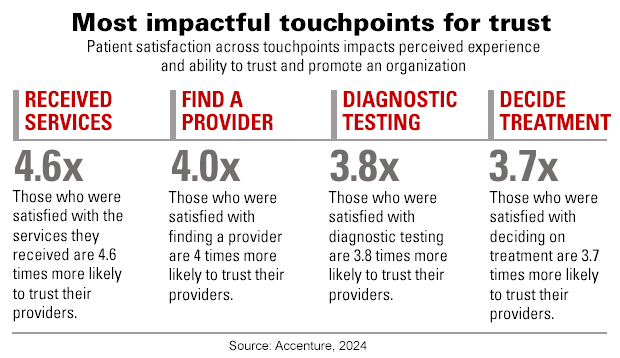

Survey: Without a Top-Notch Consumer Experience, Expect Patient Flight

As hospitals and health systems hone their focus on improving the patient experience, they may want to take a harder look at navigation challenges their consumers may be facing.
About one in five consumers switched providers in the past year and nearly 90% said they did so because the organization was hard to do business with, notes a recent Accenture report. Issues like a bad experience with the administrative staff or front desk, and digital/online service and support solutions failing to meet their needs fed into many respondents’ decisions to switch providers.
The survey, which is a follow-up study to a 2021 report, assessed patient loyalty to providers and friction points in relationships. Accenture surveyed 8,000 U.S. adults who had sought or received care in the past 12 months to understand how health care providers perform across 10 key consumer touchpoints and key drivers of provider selection and switching behaviors.

Other key factors that led respondents to change providers included:
- Clinical experience/expertise (44%). Reasons cited include a bad experience with a physician or member of the care team and found someone with more expertise for my clinical needs.
- Access (13%). Common reasons cited include inconvenient appointment hours, inability to get an appointment quickly and locations were not convenient in proximity to where the respondents live or work.
- Value (10%). Respondents felt the cost of care was not a good value for the services they received.
4 Takeaways from the Survey
1 | Access may not be everything, but it’s close.
Some 70% of consumers who switched providers cited access as a deciding factor when selecting a new provider. They want to be able to get appointments quickly, expect convenient locations and hours and they value digital tools that make navigation easier.
Takeaway
Patients have come to expect digital, mobile or social media interaction. They want to know their options for telehealth and virtual care appointments and want a direct connection to customer service.
2 | Trust matters.
More than half the respondents (53%) chose their new provider based on a recommendation or referral from a trusted primary care physician, specialist or friend.
Takeaway
Be proactive in how you engage patients in communications. Done well, promotions, marketing tools and advertising can help build trust in the community.
3 | Take it easy.
People who find that their providers are easy to work with are 84% more likely to stay with those providers than providers who aren’t.
Takeaway
Involving patients in your consumer experience improvement efforts can yield powerful insights to help your team prioritize areas that need to be addressed.
4 | Highly digital people are the most likely to be loyal.
The data found that these people also are most likely to find their providers easy to work with and trust them.
Takeaway
People in this group make digital access part of all areas of their life and are likely to have a digital-first approach to engagement — only falling back on traditional channels when digital methods fail or are unavailable. They can be a tough group to satisfy, but when you meet their expectations, they will stay and trust your organization.



